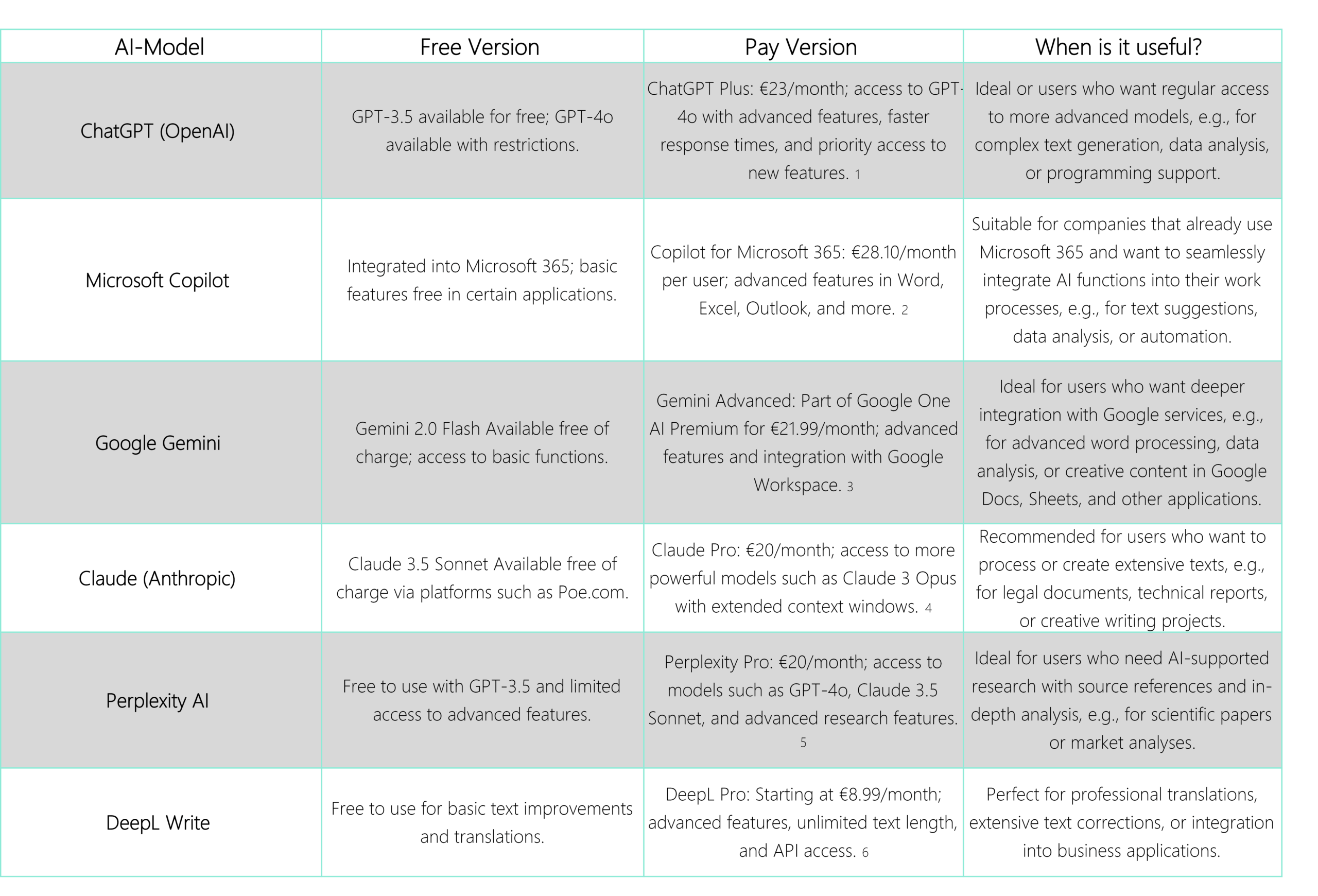What companies should consider before integrating AI into their work processes

As a consulting firm for modern ways of working, we at 3kubik see every day how great the potential of AI is and how easy it is to get lost in gimmicks or overlook important prerequisites.
That’s why we want to share our perspective: What does it take to use AI in a truly meaningful and sustainable way in a company?

Targeted instead of blind: What do I actually want to achieve with AI?
• What specific goal am I pursuing with AI? For example, do I want to:
o Save time on recurring tasks?
o Scale my marketing even with limited resources?
o Automate knowledge management or simplify processes?
At 3kubik, we use AI specifically for the structured elaboration of workshop results, for example to create guidelines, overviews of measures, or campaigns. In doing so, we consistently ensure that no personal or company-sensitive data is used, but instead work exclusively with abstracted, anonymized, or generic content. We also use AI in technical areas, such as JSON formatting in Power Automate or M formulas in Power BI, based on neutral sample data. Our use of AI is therefore compliant with the requirements of the EU AI Act and supports our work where it makes sense, safely, efficiently, and responsibly.
Practical example:
✔ Goal: Save time on workshop documentation
✉ Prompt:“Organize the results of this workshop into an action plan. Break it down into short-term, medium-term, and long-term goals. Target audience: management.”
Understanding what AI can and cannot do

AI is not a magic stick. It does not deliver truths, but rather suggestions based on data and probabilities. And it works best when used within a meaningful framework.
What AI (for exampl. ChatGPT or Microsoft Copilot) can do:
• Summarize, structure, and formulate content
• Generate ideas and optimize texts
• Analyze and visualize data
• Provide technical assistance (e.g., M formulas, JSON code, Power Automate logic)
• Speed up repetitive tasks
What AI cannot do:
• Making decisions for you
• Developing corporate strategy
• Making correct statements without context
• Improvising with common sense
• Taking into account the nuances and “human” aspects of a workshop
Our tip: AI is a tool, not a replacement for humans. But it is a damn good tool if you know how to use it.
Example of use:
✔ Prompt:Summarize this article in three bullet points for a LinkedIn post. Tone: professional but casual.
❌ Not suitable: “What is the best strategy for my company?” (too open, without context)

Prompt-Power:
Why inputs determine the outcome
A good prompt (the input or question to the AI) is often crucial for a useful result. A few rules of thumb:
• Be precise: What exactly do you want?
• Provide context: Who is the target audience? What is the goal?
• Think in terms of roles: “Act like a project manager creating a roadmap for a change project.”
• Test different variations: Trial and error is part of the process.
What we do at 3kubik:
We always develop our initial ideas for marketing content, concepts, or blog posts ourselves. Structured, targeted, and tailored to the respective message. In the next step, we use AI to refine wording, make texts more fluid, or adapt them to the tone of the respective channel. In this way, we combine technical substance with linguistic quality, efficiently but always with a human touch.
A strong prompt could look like this:
“You are a copywriter at a management consultancy for digitalization.
Goal: Write an email invitation for a webinar on the topic of ‘AI in Power Automate’.
Tone: competent, inviting.”
AI models compared:
Free vs. paid
What companies should bear in mind

Data protection & responsibility:
What companies should bear in mind
In a business context in particular, the following questions arise time and again:
- Where does the data I enter into an AI tool end up?
- Is it stored or reused for training purposes?
- Is the tool GDPR-compliant, or are there legal risks involved?
The EU AI Act and the GDPR clearly stipulate that the highest standards apply when using AI. Even the mere text content of customer feedback or an email can be considered sensitive if it allows conclusions to be drawn about a person.
Our recommendation based on practical experience:
At 3kubik, we do not enter sensitive customer data or internal content into publicly accessible AI tools. Instead:
- we work with abstracted or anonymized content,
- use closed systems with clear data management,
- or develop prompt templates that function completely independently of confidential context.
For businesses, we recommend:
Rely on AI solutions that have been specifically developed for professional use, such as Microsoft Copilot in combination with Microsoft 365. These systems offer high security standards, clear data management, and remain within your IT environment.
Those who work with particularly sensitive data or require maximum control should also consider Self-Hosting- or Private-Cloud-Model. This ensures that full control over data access, storage locations, and rights assignment remains with the company and not with the AI provider.
Typical pitfall:
❌ Prompt:“Analyze the sales figures of our top customers from the last quarter.”
✔ Instead: “Analyze anonymized sales data from a sample customer group (industry: IT services, 10–50 employees) for seasonal patterns.”


Practice at 3kubik:
Where AI brings real added value
Before AI, we put a ton of effort into a lot of these tasks, doing them in a structured way, with a lot of attention to detail, often going beyond what we originally planned. We often spent more time than we had planned because coming up with a well-thought-out, good solution was more important to us than the stopwatch.
Since we started integrating AI into our processes in a meaningful way, we have been able to prepare many of these tasks more quickly and structure them better. This means more focus on the essentials and less time spent on the peripherals.
However, it is important not to underestimate the fact that using AI also requires preparation. A well-formulated prompt, i.e., the “question” posed to the AI, has a decisive influence on the quality of the result. And even after that, adjustments are usually still necessary, whether in terms of content, style, or structure. The creative thinking remains with us; only the path to the goal has become shorter.
Here are a few specific examples of how we use it in our everyday work:
- Workshop follow-up: We use AI to structure results and ideas, e.g., in the form of catalogs of measures or guidelines, based exclusively on non-personal and abstract content.
- Technical support: In Power Automate and Power BI, we use AI to efficiently develop formulas, JSON logic, or formatting, using generic sample data, never real user data.
- Marketing & communication: Initial concepts and drafts continue to come from our team. AI helps to refine them linguistically and play them out fluently and in a target group-oriented manner, depending on the channel (LinkedIn, website, newsletter).
Prompt examples:
- Workshop follow-up: “You are an organizational developer in a consulting firm. Structure the following workshop results in a clear catalog of measures with the following categories: field of action, responsible persons, effort (high/medium/low), implementation period (short/medium/long term). Make recommendations for prioritization for the next team meeting.”
- Power Automate: “Generate JSON formatting for a SharePoint list in which the status column is automatically color-coded: green for ‘Completed’, yellow for ‘In progress’, red for ‘Overdue’. Output the complete JSON code and explain the most important logic sections in one sentence.”
- Communication: “You are a content editor at a digital transformation company. Goal: Turn the blog article below into three social media posts. Version 1: informative for LinkedIn. Version 2: inspiring for Instagram with a suitable hook. Version 3: dialogue-oriented with a closing question for X (formerly Twitter). Give each post an appropriate length, hashtags, and emoji support if necessary.”
Conclusion:
AI as a sparring partner – conscious, human, effective
Now that AI-generated texts and images can be recognized on many channels, it is clear that technology is no substitute for care. Content appears interchangeable if it is not edited, which is a shame. Even though AI takes a lot of work off our hands, it is still worth putting in the effort yourself at the end. This ensures that a text not only sounds correct, but also human, personal, relevant, and with rough edges.
At 3kubik, we show our customers where AI can be used effectively to work more efficiently and create space for what really matters, whether in marketing, workshop follow-up, or technical support. Not automated, but well thought out. Not as a replacement, but as a tool with potential.
Curious? 😉
If you want to know how AI can also support your work processes in a meaningful way, get in touch with us. We’ll show you how to use AI correctly: in a structured, secure way that delivers real added value.
Artificial intelligence was used to assist in the creation of this article. The content was editorially reviewed, revised, and adapted to our quality standards.

